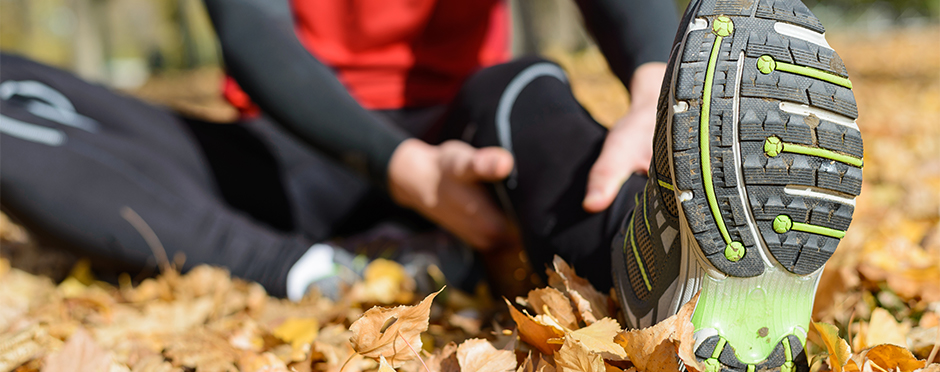
How Physical Therapy Can Get You Stronger for Your Next Marathon
Leave a CommentThe running landscape has changed quite a bit as a result of the global pandemic. Running a marathon, even virtually, is perhaps one of the most challenging accomplishments that a person may embark on in their lifetime, requiring both physical and mental strength. During training and on race day, physical limitations are pushed to the brink via muscular and respiratory fatigue. Mental willpower is tested as oftentimes you keep going when everything else in your body is telling you to “stop.” Preparation is paramount for success in running a marathon, and though choosing a correct endurance plan and running group is important, there are other components that will help you run your next 26.2-mile journey with even greater success.
What to Expect from Your Training Plan
Most marathon training plans are 16 to 20 weeks long, consist of three to five runs each week, and increase your mileage as you near race day.1 Training plans are essential to follow as they help participants get used to running long distances at specific paces, as well as allowing rest time for the body to recover. However, there are other factors aside from endurance and increasing mileage that need to be considered as well. The end of certain training plans suggests running upwards of 35 miles per week. As this mileage leaves you feeling sore, you may ask, “how do I know what is good pain versus bad pain?” “Are my muscles strong enough to withstand doing this in the first place?” “Am I at greater risk for developing a stress fracture?” All of these are valid questions, so knowing where to find the correct answers and adding supplementary materials to your training may help.
Injuries During Training
Injuries from training for a marathon are very common. In a study of 161 runners performed by the Journal of Orthopedic and Sports Physical Therapy, it was found that nine out of every ten runners reported a running-related injury from overuse at some point during the sixteen weeks leading up to training for a half or full marathon.2 That seems like an intimidating number. Fortunately, with the correct program, professional help, and strengthening of important muscles, runners may reduce their risk of developing overuse injuries.
Strengthening Muscle Groups
There are certain muscle groups that tend to be forgotten during training but are essential to improving your running performance. For example, your gluteus maximus muscle is one of the strongest muscles in the human body and is critical for running. It performs an action called “hip extension,” which happens during every step of running. Other important areas for running are stabilizing your core musculature, strengthening your hip abductors and training your quadriceps, as these will all improve lower extremity stability. Having adequate flexibility in your legs is also important and stretching should be incorporated after each run.
Exercises to Supplement Your Training
There are several exercises that can easily be added to your workout routine, either before beginning or during your marathon training. Below, a list of several exercises to try are provided. Supplementing your race training program with thorough strengthening and flexibility exercises will benefit your overall fitness level prior to embarking on your journey.
- Planks
- Maintain this neutral position with bearing weight on your forearms and feet only. This will improve abdominal strength. Start with 30 seconds holds and progress to longer times as tolerated.
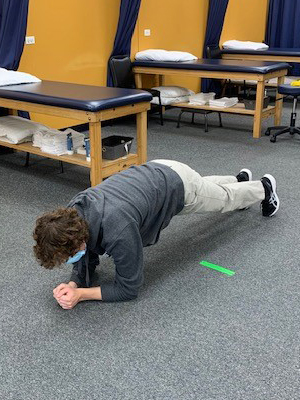
- Side Steps
- Wrap a resistance band around your ankles and keep your toes pointed forward. Step side to side to work your hip abductor muscles.
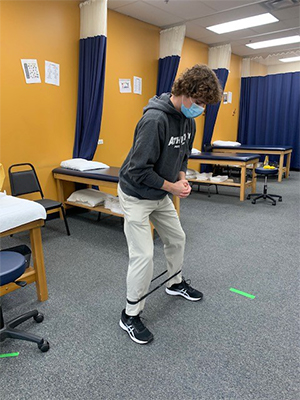
- Side Plank with Clams
- Begin as the first picture shows, holding a side plank with a resistance band above your knees.
- Maintain the side plank position and move your knee up against the band. Start with performing 3 sets of 10 on each side to strengthen core and hip musculature.
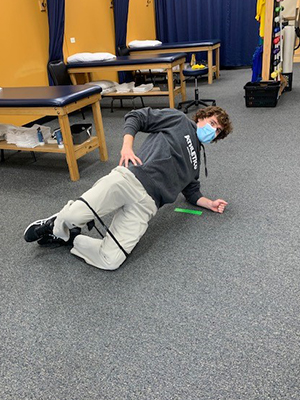
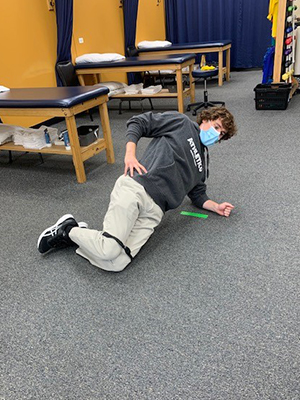
- Slow Step Downs
- Using a standard step in your home, slowly lower your opposite heel to the floor to work on quadricep stability and knee control. Perform 3 sets of 10 on each side.
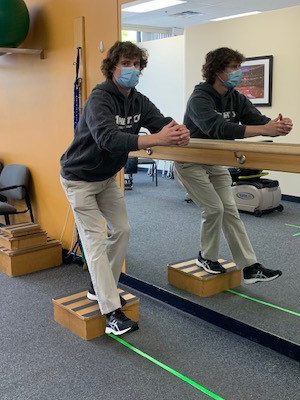
- Hamstring Stretch
- Keep your heel on the chair, keep your knee straight and slightly lean forward. You should feel a stretch in the back of your thigh/upper leg. Hold this position for 30 seconds on each side.
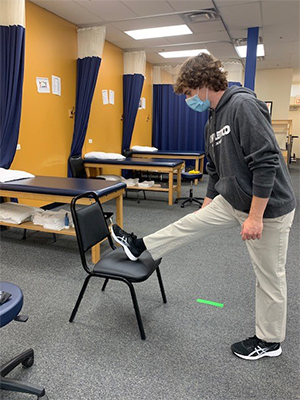
- Quadriceps Stretch
- Stand next to a steady surface for balance if needed. Bend your knee and hold your foot with your hand until you feel a stretch in the front of your thigh. Hold this position for 30 seconds on each side.
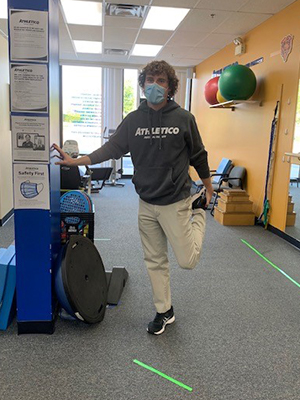
- Calf Stretch
- Place hands on a wall. Keep your right knee bent and move your left leg back so your heel touches the floor. You should feel a stretch in the back of your left lower leg. Hold this position for 30 seconds and then switch leg position to stretch the right calf.
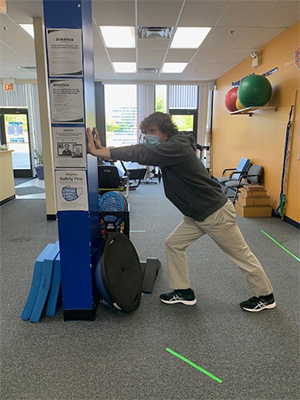
Each person is unique and has their own strengths and weaknesses. In order to identify some of these, reach out to an Athletico physical therapist for a free assessment or evaluation. Our endurance experts will perform a thorough motion screen and evaluate your strength at your first appointment, providing you with a game plan to successfully accomplish your goals and keep you running strong! Free assessments are available in-clinic and virtually through our telehealth platform.
Physical therapy is usually the thing you are told to do after medication, x-rays or surgery. The best way to fix your pain is to start where you normally finish – with physical therapy at Athletico. Schedule a free assessment in-clinic or virtually through a secure online video chat where our team can assess your pain and provide recommended treatment options.
The Athletico blog is an educational resource written by Athletico employees. Athletico bloggers are licensed professionals who abide by the code of ethics outlined by their respective professional associations. The content published in blog posts represents the opinion of the individual author based on their expertise and experience. The content provided in this blog is for informational purposes only, does not constitute medical advice and should not be relied on for making personal health decisions.
References:
1. McGuire, Jane. “How to Run a Marathon – Free Marathon Training Plans for Every Kind of Runner.” Runner’s World, Runner’s World, 21 Nov. 2019, www.runnersworld.com/uk/training/marathon/a776459/marathon-training-plans/
2. Franke, Thierry P.c., et al. “Running Themselves Into the Ground? Incidence, Prevalence, and Impact of Injury and Illness in Runners Preparing for a Half or Full Marathon.” Journal of Orthopaedic & Sports Physical Therapy, vol. 49, no. 7, 2019, pp. 518–528., doi:10.2519/jospt.2019.8473.
